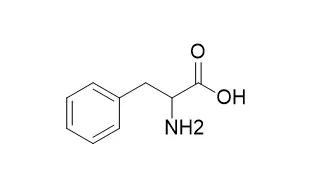| In vitro: |
| Medical Hypotheses, 2000, 55(4):283-288. | | DL-phenylalanine markedly potentiates opiate analgesia – an example of nutrient/pharmaceutical up-regulation of the endogenous analgesia system.[Reference: WebLink] |
METHODS AND RESULTS:
In the author’s clinical experience, concurrent treatment with
DL-Phenylalanine (DLPA) often appears to potentiate pain relief and also ease depression in patients receiving opiates for chronic non-malignant pain. An analysis of this phenomenon suggests that it may be mediated, at least in part, by up-regulation of the ‘endogenous analgesia system’ (EAS), a neural pathway that projects caudally from medullary nuclei to the dorsal horn of the spinal column; when stimulated by chronic pain or therapeutic measures such as opiates or acupuncture, the EAS suppresses activation of second-order pain-receptive neurons in the dorsal horn, and thereby alleviates pain. Since serotonin and enkephalins are key neurotransmitters in the EAS, it is reasonable to predict that measures which promote serotonin activity (such as 5-hydroxytryptophan and serotonin-reuptake inhibitors) as well as enkephalin activity (such as D-phenylalanine, an enkephalinase inhibitor) should potentiate EAS-mediated analgesia – a view consistent with much previous medical research.
CONCLUSIONS:
Comprehensive support of the EAS with well-tolerated nutrients and pharmaceuticals may amplify the analgesic efficacy of chronic opiate therapy, while enabling dosage reductions that minimize opiate side-effects. Analogously, this approach may complement the efficacy of acupuncture and other analgesic measures that activate the EAS. | | Journal of the Korean Society of Food ence & Nutrition, 2007, 55(2):11-27. | | Processing Properties of DL-Phenylalanine in Aqueous Solution.[Reference: WebLink] | DL-Phenylalanine (DLPA) is known as an essential amino acid exhibiting opiate capacities by inhibiting the degradation of enkephalins. From the viewpoint of developing a drink containing DLPA, its solubility and stability in aqueous solutions were investigated at some processing conditions such as temperature and pH.
METHODS AND RESULTS:
When the solubility was analyzed by transmittance at 600 nm, the solutions containing DLPA of 0.1% to 2% showed transmittance over 98% above and over 99% at wide range of pH (3.0, 7.0, and 10.0). The valuable stability was also recognized through HPLC analysis for DLPA content, that is, 61-71% DLPA was still remained even after processing at high temperature and wide pH range, indicating the possibility of de-velopment of drink containing DLPA.
CONCLUSIONS:
Among flavors considered for the improvement of consumers` acceptability on drink, orange and amino acid flavors were superior to others. Microbial growth was not detected during 6-week storage after drink preparation.
|
|






 Cell. 2018 Jan 11;172(1-2):249-261.e12. doi: 10.1016/j.cell.2017.12.019.IF=36.216(2019)
Cell. 2018 Jan 11;172(1-2):249-261.e12. doi: 10.1016/j.cell.2017.12.019.IF=36.216(2019) Cell Metab. 2020 Mar 3;31(3):534-548.e5. doi: 10.1016/j.cmet.2020.01.002.IF=22.415(2019)
Cell Metab. 2020 Mar 3;31(3):534-548.e5. doi: 10.1016/j.cmet.2020.01.002.IF=22.415(2019) Mol Cell. 2017 Nov 16;68(4):673-685.e6. doi: 10.1016/j.molcel.2017.10.022.IF=14.548(2019)
Mol Cell. 2017 Nov 16;68(4):673-685.e6. doi: 10.1016/j.molcel.2017.10.022.IF=14.548(2019)